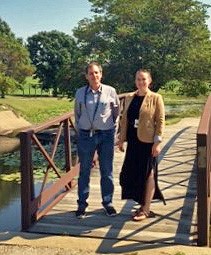We Must Work Together to Build Resilience in Communities Facing Climate Change
By Kelly Overstreet
EPA brings in students every summer to work, learn practical environmental skills, and enhance their educational experience through our Pathways Intern Program. The Big Blue Thread is proud to feature several blogs written by these interns, focusing on what motivates them to work in the environmental sector and what attracted them to EPA. We’ve already posted blogs by Andrew Speckin and Sara Lamprise. Our third blog is by Kelly Overstreet, who continues to intern with our Program Operations and Integration staff.
In August, I attended a fascinating Climate Change Workshop, sponsored by the Nebraska Silver Jackets, with my EPA colleague Robert Dunlevy. Silver Jacket groups partner with federal and state agencies to manage flood risk at the state level. Bob made a presentation on EPA’s Climate Resilience Evaluation and Awareness Tool (CREAT), a software tool to assist drinking water and wastewater utility owners and operators in understanding potential climate change threats and assessing the related risks at their individual utilities. As an intern, I went along to gain some valuable, direct experience in collaborative problem-solving.
As we drove north to the workshop at the Lewis and Clark Missouri River Visitors Center in Nebraska City, Bob used the trip as a teaching opportunity, noting sites of loess (windblown sediment), commenting on the heights of various rivers and streams, and discussing the variety of unique geological structures here in the Heartland. Many of these lessons were anecdotal, relating to his 25 years of experience working with communities as an EPA representative.
Bob reminded me of the unique position EPA plays as a U.S. regulatory agency. We have a broad mission to ensure that “all Americans are protected from significant risks to human health and the environment where they live, learn and work.” In achieving that mission, we as federal employees must focus on our individual contributions to help achieve EPA’s overall goal.
In economics, there is the phenomena of “agglomeration economies.” While the concept can get quite technical very quickly, the general idea is that businesses are most successful when they exist in proximity to each other. This allows for the exchange of tacit knowledge between businesses that provide goods and services both laterally across sectors and vertically within.
However, such knowledge doesn’t only exist in the private sector. Upon arriving at Nebraska City, I had the opportunity to witness the power of tacit knowledge firsthand. The workshop offered a series of lectures and talks from several federal, state, and local agencies directly involved in flood resiliency and adaptation measures.
Not surprisingly, we joined representatives from the Federal Emergency Management Agency and the U.S. Army Corps of Engineers, all with different missions and different sets of tools for accomplishing their goals. And yet, through the collaborative process of sharing knowledge and asking questions, I left with a much stronger sense of the challenges we face in coping with extreme weather events.
Sometimes our role in EPA’s mission can feel piecemeal, but to best achieve our mission, we must form partnerships and foster relationships. Each of us has a different focus and knowledge set, but as long as we continue to have conversations, like at the Silver Jackets training, we don’t have to be limited by the specific priorities that shape our service.
About the Author: Kelly Overstreet is a Student Intern at EPA Region 7, who worked full-time this summer and will continue part-time during the school year. She is a graduate student at the University of Kansas, earning master’s degrees in urban planning and human geography. Kelly’s graduate research focuses on how municipal climate planning can address issues of environmental justice and social equity. She’s a cat lady, and proud to show off her pet photos.




Oct 14, 2015 @ 11:03:45
We all face climate changes and we all need to do something helping to turn things around. And coming together in communities is a start, Recycle , reuse to reduce mankind foot prints on earth.
Oct 14, 2015 @ 11:08:35
We all face climate, And communities coming together to do something is a start.
Recycle , Reuse to Reduce mankind foot prints.